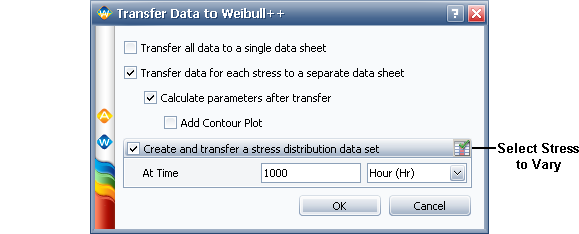![]()
![]()
| Related Topics: | ||

The Transfer Data to Weibull++ window is used to transfer the data in an ALTA standard folio data sheet to a Weibull++ standard folio. This allows you to perform life data analysis on your accelerated test data. For example, you could use this window to separately analyze the data obtained from each stress level from the accelerated testing. To access the window, click the Transfer Data to Weibull++ icon on the control panel.
![]()
After you click the icon, you will have the option to either transfer the data to a single Weibull++ data sheet or transfer it to multiple sheets.
If you select the Transfer all data to a single sheet check box, the subset ID column of that sheet will display the stress level at which each data point was obtained. (If desired, you can then use the Batch Auto Run tool to extract data subsets from the data sheet.)
If you select the Transfer data for each stress to a separate data sheet check box, the data will be grouped according to stress level (where, in multiple-stress situations, a stress level is a combination of stress values), and then each group will be placed into its own data sheet.
If you select to transfer the data to multiple sheets, the Calculate parameters after transfer check box will appear. Select this check box if you wish to have the software automatically calculate each data sheet using the life distribution from your selected model. If you select this check box, you will also have the option to automatically add a Contour plot that will compare the calculated parameters for each data sheet. For example, you could use this plot to help you determine whether the shape parameter estimates for the data obtained at different stress levels differ significantly at a specified confidence level.
This window also includes a check box labeled Create and transfer a stress distribution data set. If you select this option, the tool will calculate the product's unreliability at the specified time and at eleven different stress levels. The different stress levels will range from the use stress level to the maximum stress level used in the test, with equal increments in between. This information will then be exported to a free-form data sheet in a new Weibull++ standard folio, like the data sheet shown next.

In this example, the product's use stress level is 356 K, and the maximum stress level used in the test is 426 K. Thus, the X-axis values range from 356 to 426. The Y-axis values represent the unreliability (as a percentage) for each stress level. So, if the time specified in the Transfer Data to Weibull++ window was 1,000 hours, then, according to the first row of this data sheet, the product has a probability of failure of 31.57% at 1,000 hours at a stress level of 356 K. If you wish, you can calculate this data to further analyze the relationship between stress level and unreliability.
In multi-stress situations, the Select Stress to Vary icon will be enabled in the window, as shown next.

If you click this icon, a window will appear that allows you to select which stress type will be varied in the software's unreliability calculations. The remaining stress types will be fixed at their specified use stress values.
© 1992-2013. ReliaSoft Corporation. ALL RIGHTS RESERVED.